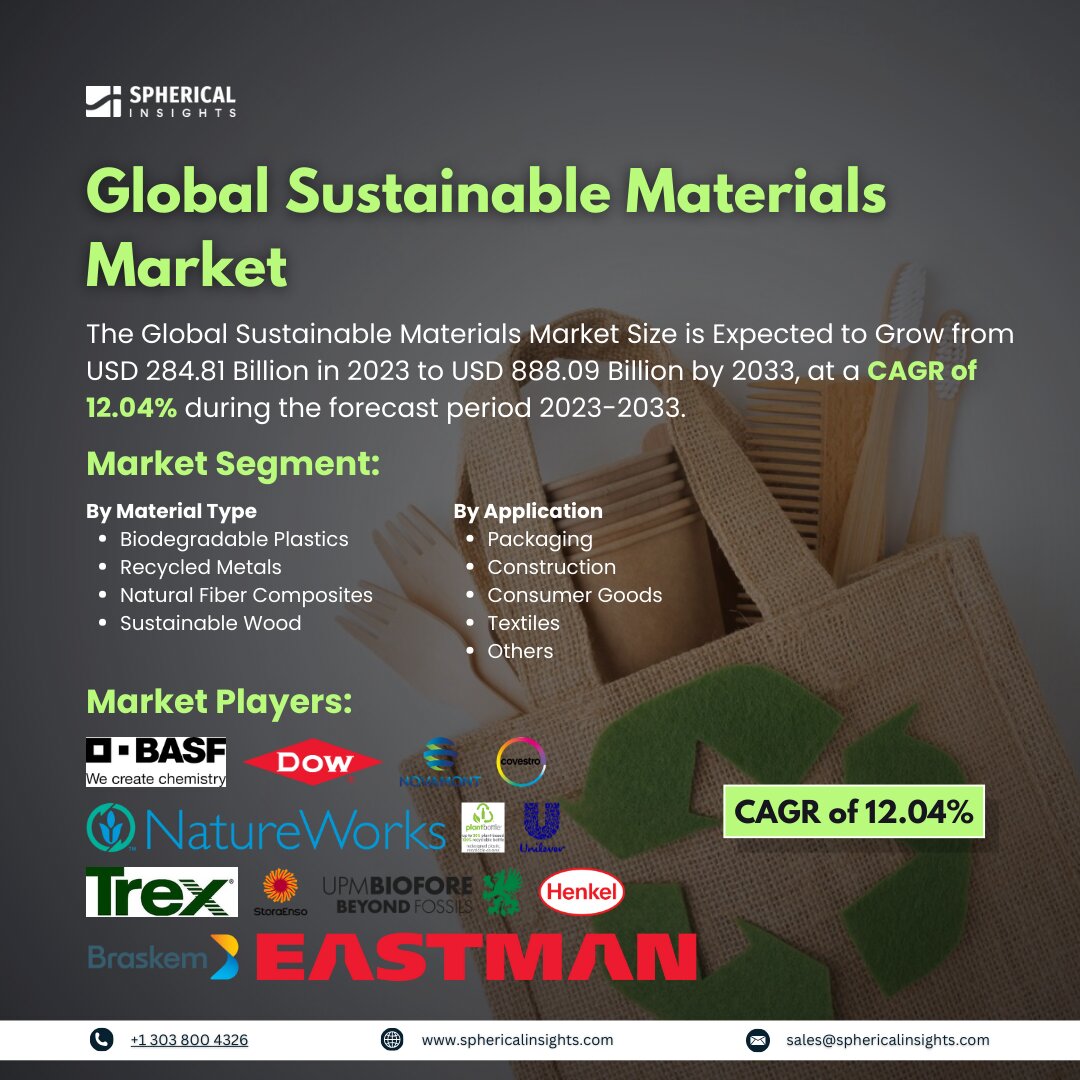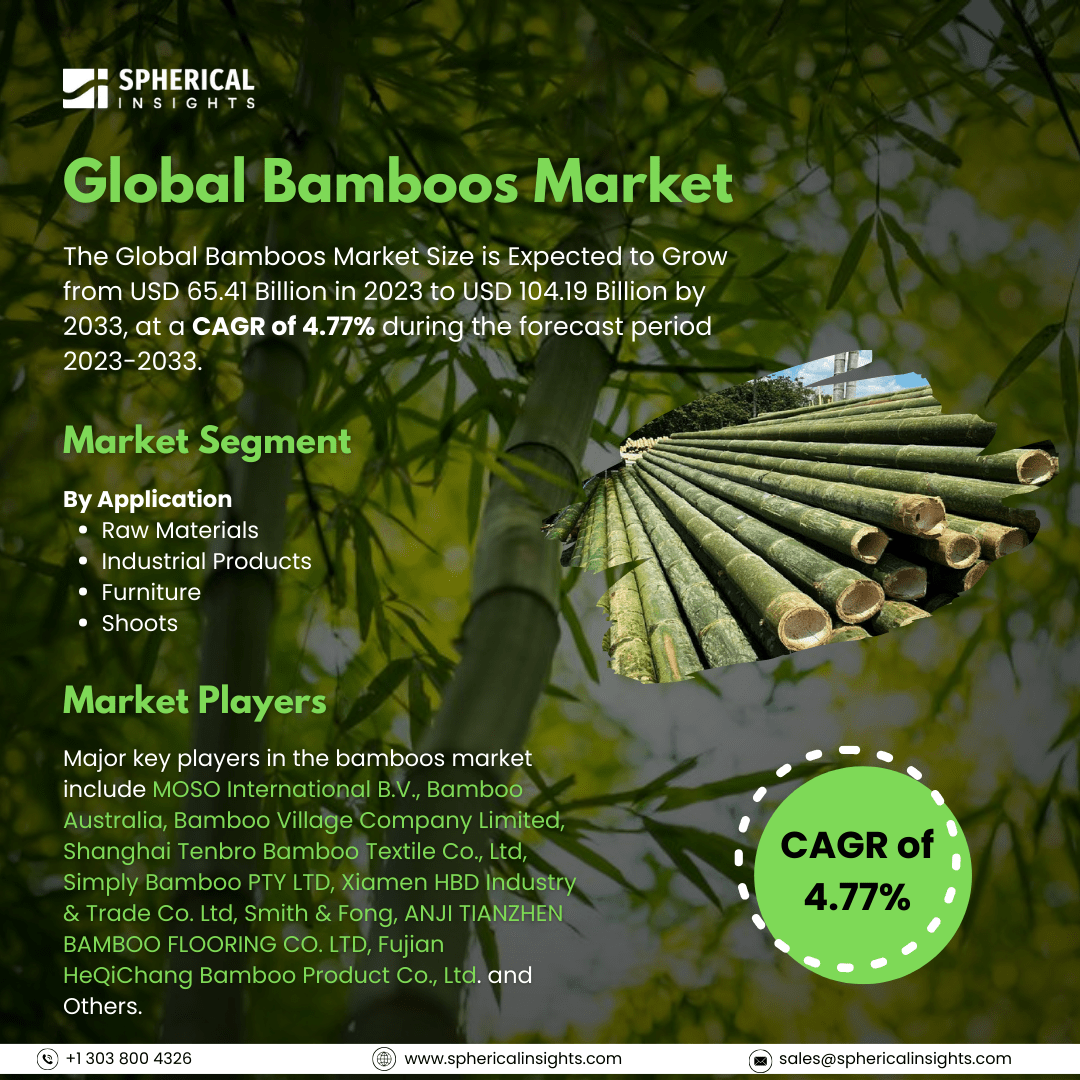Global Sustainable Materials Market Size to worth USD 888.09 Billion by 2033
According to a research report published by Spherical Insights & Consulting, the Global Sustainable Materials Market Size is Expected to Grow from USD 284.81 Billion in 2023 to USD 888.09 Billion by 2033, at a CAGR of 12.04% during the forecast period 2023-2033.
Browse key industry insights spread across 210 pages with 110 Market data tables and figures & charts from the report on the Global Sustainable Materials Market Size, Share, and COVID-19 Impact Analysis, By Material Type (Biodegradable Plastics, Recycled Metals, Natural Fiber Composites, and Sustainable Wood), By Application (Packaging, Construction, Consumer Goods, Textiles, and Others), and By Region (North America, Europe, Asia-Pacific, Latin America, Middle East, and Africa), Analysis and Forecast 2023 – 2033.
Resources used in manufacturing and construction that have a low lifetime environmental effect are known as sustainable materials. These materials are usually made using less energy, come from renewable sources, and are made to be recyclable and long-lasting. Sustainable materials contribute to pollution reduction, resource conservation, and the development of a circular economy by utilizing "green" concepts like recycling and a decreased reliance on fossil fuels. Recycled plastics, hemp, bamboo, and organic cotton are a few examples that support social, economic, and environmental sustainability. Customers' growing concern for the environment and desire to lessen their carbon footprints is fueling the demand for goods manufactured using environmentally friendly materials and production techniques. For products bearing eco-labels and green certifications, consumers are prepared to spend more. The sustainable materials sector is expanding as a result of this change in consumer expectations. Recycled, bio-based, and lower-carbon materials are being adopted by businesses in a variety of industries; several apparel labels have introduced collections made from recycled polyester, bamboo, or organic cotton. However, high production costs and extensive research and development for sustainable materials increase initial production costs and capital expenditures, making them a significant market challenge.
The biodegradable plastics segment is predicted to hold the highest market share through the forecast period.
Based on the material type, the sustainable materials market is classified into biodegradable plastics, recycled metals, natural fiber composites, and sustainable wood. Among these, the biodegradable plastics segment is predicted to hold the highest market share through the forecast period. This is due to growing environmental consciousness. As the demand for environmentally friendly products rises, biodegradable plastics have become the most popular sustainable material. These polymers are renewable plant-based materials that break down without producing harmful byproducts due to their cellulose, sugarcane, and corn starch origins.
The packaging segment is anticipated to hold the greatest market share during the projected timeframe.
Based on the application, the sustainable materials market is divided into packaging, construction, consumer goods, textiles, and others. Among these, the packaging segment is anticipated to hold the greatest market share during the projected timeframe. This is because it is widely used for both food and non-food goods in many different industries. For companies looking to lessen their carbon footprint and satisfy environmentally concerned customers, packaging made from bio-based materials like paper, bioplastics, and recycled metals offers an environmentally benign yet incredibly practical alternative.
Europe is estimated to hold the largest share of the sustainable materials market over the forecast period.
Europe is estimated to hold the largest share of the sustainable materials market over the forecast period. The region leads the global sustainable materials market due to government support, regulatory measures, and initiatives like those in Germany and France. Major automotive and construction companies in the region also contribute to the demand for sustainable alternatives, promoting the circular economy and renewable materials.
Asia Pacific is predicted to have the fastest CAGR growth in the sustainable materials market over the forecast period. The market is driven by China, India, and other developing nations. These nations are prioritizing sustainable infrastructure development and reducing manufacturing carbon footprint, with policies focusing on green technologies and resource conservation.
Competitive Analysis
Major key players in the sustainable materials market include BASF SE, Dow Inc., NatureWorks LLC, Novamont S.p.A., Trex Company, Inc., Stora Enso Oyj, UPM-Kymmene Corporation, Braskem S.A., Eastman Chemical Company, Covestro AG, Coca-Cola Company (PlantBottle), Unilever, IKEA (Sustainable Wood Products), Henkel AG & Co. KGaA, and Procter & Gamble Co., and Others.
Recent Development
- In September 2024, Birla Carbon introduced Continua 8030 SCM, a sustainable circular material, to help customers achieve environmental goals and demonstrate their commitment to sustainability and innovation. This addition broadens Birla Carbon's product range and demonstrates its commitment to integrating circularity into its innovation strategy.
Key Target Audience
- Market Players
- Investors
- End-users
- Government Authorities
- Consulting And Research Firm
- Venture capitalists
- Value-Added Resellers (VARs)
Market Segment
This study forecasts revenue at global, regional, and country levels from 2023 to 2033. Spherical Insights has segmented the sustainable materials market based on the below-mentioned segments:
Global Sustainable Materials Market, By Material Type
- Biodegradable Plastics
- Recycled Metals
- Natural Fiber Composites
- Sustainable Wood
Global Sustainable Materials Market, By Application
- Packaging
- Construction
- Consumer Goods
- Textiles
- Others
Global Sustainable Materials Market, By Regional Analysis
- North America
- Europe
- Germany
- UK
- France
- Italy
- Spain
- Russia
- Rest of Europe
- Asia Pacific
- China
- Japan
- India
- South Korea
- Australia
- Rest of Asia Pacific
- South America
- Brazil
- Argentina
- Rest of South America
- Middle East & Africa
- UAE
- Saudi Arabia
- Qatar
- South Africa
- Rest of the Middle East & Africa



